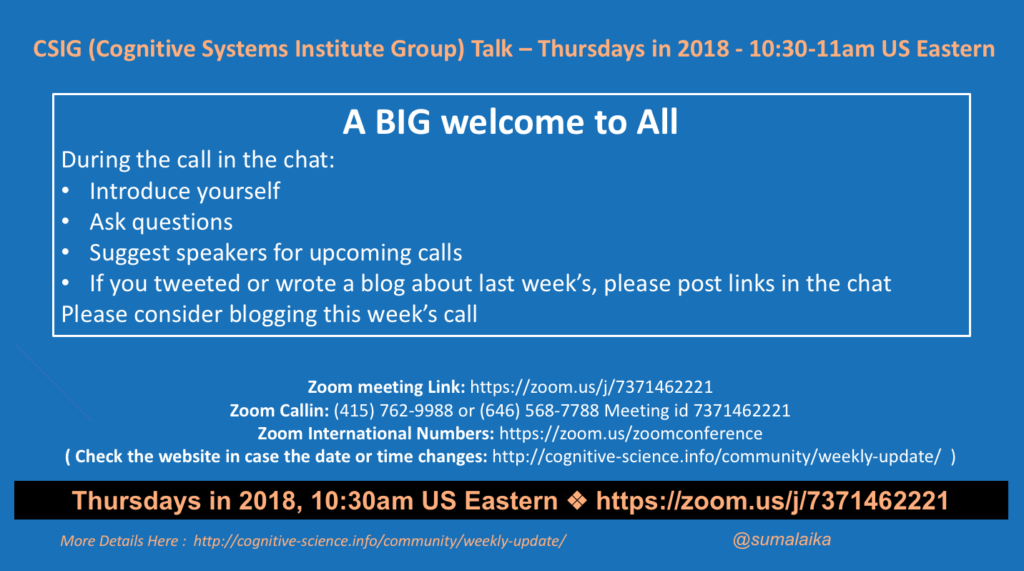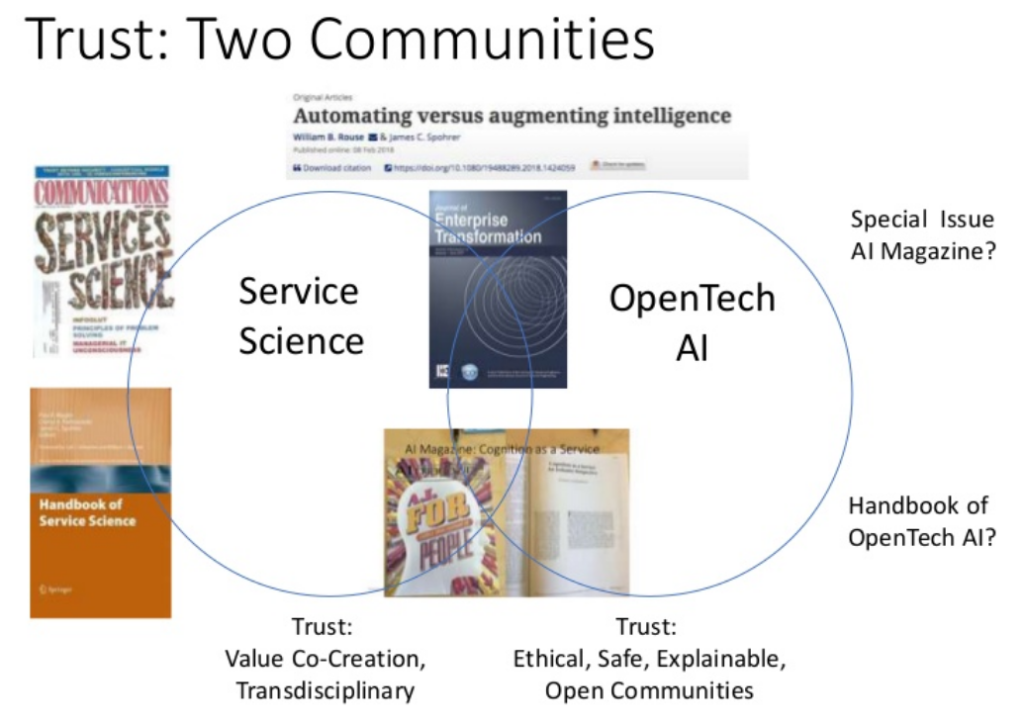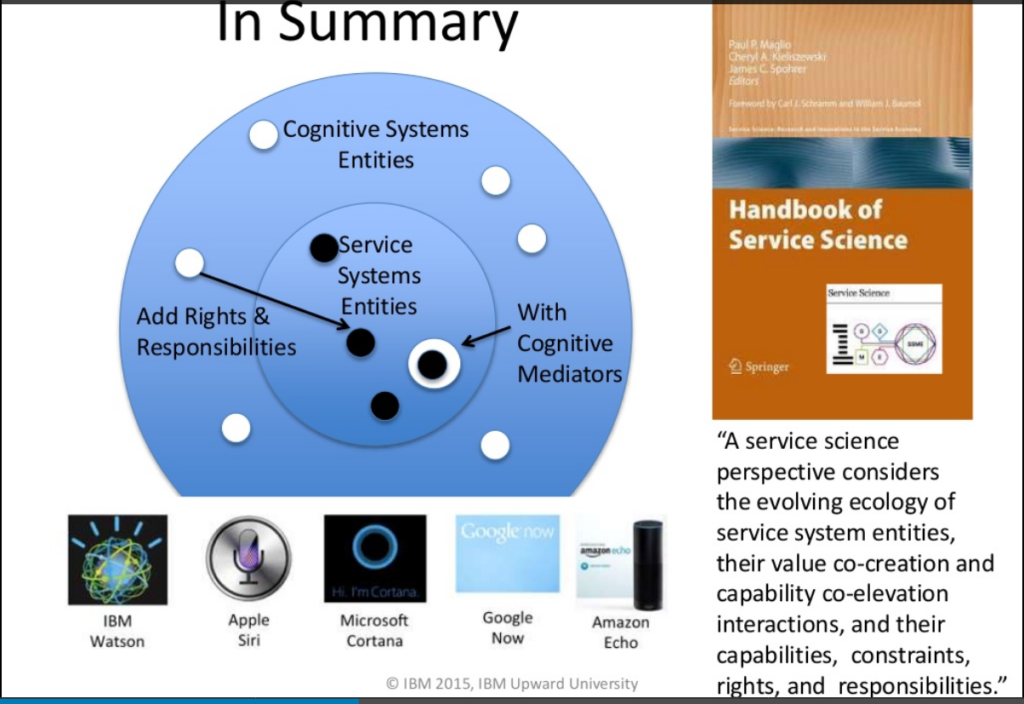Hastings H & Saperstein J (2018) The Interconnected Individual: Seizing Opportunity in the Era of AI, Platforms, Apps, and Global Exchanges. Business Expert Press.
The Interconnected Individual:
Seizing Opportunity in the Era of AI, Platforms, Apps, and Global Exchanges
Hunter Hastings Jeff Saperstein
This book is one in the collection called: Service Systems and Innovations in Business and Society Collection,
Jim Spohrer and Haluk Demirkan, Editors
Don’t Panic! Read This Book
Some individuals (including a lot of parents) are worried about the future of work for the next generation. Technology innovation is reshaping the world of work, and breaking the old social contracts for workers previously based on institutions of higher education, high growth businesses, and government as stimulus… so what is an individual to do? In short, don’t panic, read this book; and then put its many lessons into practice. Guided by empathy, the interconnected individual is a solution seeker, a network builder, and above all an optimist – who see opportunities where others see uncertainty. The challenge is well described in the advanced praise for this book… two of twelve, shared below:
“Technology innovation is reshaping the world of work in profound and unexpected ways. People from every walk of life are anxious about their vocational future and economic security. Firms must navigate new waters in building their future workforces and developing leadership corps while also reimagining the physical and digital relationships with the people who make their business tick. Schools, colleges, and training institutions are seeing their markets disrupted by new models of learning that are geared to the constantly shrinking half-life of knowledge and know-how. And local, state, and national governments are facing intense pressure to refocus investments and policies on their human capital stock in order to remain competitively relevant in the global economy. The world of work is undergoing massive shifts that not only redistribute opportunities among people and machines but also bring into the fold billions of people who traditionally were left behind. The Interconnected Individual is an invaluable compass for anyone seeking to understand these new forces, navigate these novel challenges, and reposition themselves for the opportunities of the future.”
—Dr. Guy Halfteck, Founder and CEO, Knack Corporation
“The world of work has changed dramatically over the last 30 years with PCs replacing secretaries and the concept of a ‘job for life’ all but evaporating. Technologies like artificial intelligence remind us that we are currently at the beginning of this journey and the one thing we know about the future of work is that it is unpredictable. So how do we cope with the new realities? In their new book The Interconnected Individual, Jeff Saperstein and Hunter Hastings offer a unique approach based on individual self-reliance to chart a successful path through an ever-changing world. The authors cite a rich body of examples drawn from their wealth of experience in industry and academia, but this book offers more than just a conceptual framework. This is a hands- on text with many exercises that will help you cultivate an entrepreneurial mindset and build the skills you need in the modern workplace.”
—Daryl Pereira, IBM Creative Content Director, Watson & Cloud Platform
Contents
Preface …………………………………………………………………………………………………………………………………….xi
Acknowledgment…………………………………………………………………………………………………………………….xiii
Introduction ……………………………………………………………………………………………………………………………..xv
Chapter 1 The Future of Work Will Be the Sum of Our Individual Life Choices ……………………………….1
Chapter 2 Prepare Yourself for Success in the Interconnected Era………………………………………………..13
Chapter 3 The Technologies of Spontaneous Order: How Interconnected Individuals Are Augmented.25
Chapter 4 The Entrepreneur Economy ………………………………………………………………………………………37
Chapter 5 How to Navigate Your Career…………………………………………………………………………………….59
Chapter 6 The Democratization of Finance Spurs Innovation………………………………………………………..75
Chapter 7 Interconnecting, Intelligence, and Inter-Being …………………………………………………………….95
Chapter 8 Interconnected Learning: Technology Closes The Skills Gap…………………………………………111
Chapter 9 Interconnected Clusters Will Accelerate Global Integration for Opportunity…………………….119
Chapter 10 A Higher Quality of Life in a Transformed Society………………………………………………………131
Bibliography ………………………………………………………………………………………………………………………………139
Books, Case Studies, and Articles Co-authored by Hunter Hastings and Jeff Saperstein…………………144
About the Authors…………………………………………………………………………………………………………………………145
Index …………………………………………………………………………………………………………………………………………147
Preface
“The Interconnected Individual is significantly different from our past work. … These prior works were written for business executives, mostly in large organizations, who were aiming to increase growth … The Interconnected Individual is directed to a different audience in a different technological era and answers a different challenge … We all face a great question … “It isn’t technology that puts people out of work; it’s the decisions we make about how to apply it.”1 1 T. O’Reilly. 2017. What’s the Future and Why It’s Up to Us (New York, NY: Harper Collins Publishers), p. 371.”
Acknowledgements
“Mariela A. Gonzalez assisted Jeff and Hunter as editor, proofreader, researcher, and compiler. Without her excellent and painstaking work, this project would never have been completed.”
Introduction
Jeff: “Most of them, like me, had come from lower middle-class homes, where their parents worked in jobs, not careers, and were familiar with only a few career paths that they themselves experi- enced in their community.”
Hunter: “I was born in England, in the midst of its socialist experiment. In a class- riven society; my parents were tagged as “working class,” which automati- cally limited access to “The Inner Ring.””
“While many of our students went on to terrific positions in other companies, the experience of this hiring bias seared our determination to devote our work together to fostering the democratization of opportunity for more than the chosen connected.”
“This book is intended to help those who seek to do work that matters, to start a company, to grow a business, to pursue an individual career, or to innovate with others. ”
Especially see Key Themes and Who is an Entrepreneur? in the Introduction.
Chapter 1 The Future of Work Will Be the Sum of Our Individual Life Choices
“We seem to be at a pivotal point in history. Will there be jobs and careers for those who want them?”
“The most important question is not whether AI will displace and replace jobs, but will there be a societal and individual reorientation to use AI in ways that promote meaningful work and service to improve social impact and quality of life? The technology is neutral; our focus must be on how we will change to apply it for ourselves and for each other.”
“The entrepreneur—the bearer of all the uncertainty—is the driver of this market. The entrepreneur receives and interprets the signals from consumers and translates them into new solutions and new value. AI helps, but humans decide.”
“We all must be entrepreneurs. In this context, the term “entrepreneur” takes on a new meaning. It is the attitude and method of attempting to identify future consumer needs and future opportunities…”
“As empathic service-oriented individuals, we will find we have universal access to resources that help us expand our scope and raise our game.”
“In this book, we focus on how the individual economy might emerge and develop and how you prepare and resource yourself for autonomy and mastery and we aim to give insight into the key drivers to help you harness them for your own purposes.”
Chapter 2 Prepare Yourself for Success in the Interconnected Era
“It’s useful to reimagine our personal success in the emergent new era. We offer a framework for your personal adaptive thinking and a model for your individual behavior.”
“Up-skilling is an ongoing new imperative for action in the socio-technical economy.”
“Figure 2.1 Foundational cognitive and metacognitive practices (KnowledgeWorks)2”
“Empathy is the critical skill for success in the world of AI and human augmentation”
“Figure 2.2 The Interconnected Individual”
“We already can see that the smartphone has become one of the prime enablers of freelance, independent work activity. Today, 34 percent of the U.S. workforce are freelancers, according to a recent survey from the Freelancer’s Union.”
Chapter 3 The Technologies of Spontaneous Order: How Interconnected Individuals Are Augmented
“Figure 3.1 Technologies of spontaneous order”
“In the first category of starting conditions are those that augment the capabilities of the individual via great access to knowledge and machine learning/machine intelligence.”
“The second category is disintermediation—making service systems bet- ter, faster, and at a lower cost by cutting out middlemen, back rooms, and intermediate process steps and replacing them with peer-to-peer exchange. Blockchain is the leading emergent technology of disinter- mediation …”
“In the third category are global market exchange platforms, where mul- tiple parties on multiple sides of a platform can exchange, collaborate, assemble teams and disassemble teams, and create short-term or long-term single outcome-focused project collaborations. ”
“Entrepreneurs Co-create and Co-construct Based on Networks”
Chapter 4 The Entrepreneur Economy
“The new economy is driven by people who play two important roles: con- sumers and entrepreneurs. ”
“The future is uncertain. Entrepreneurs bear that uncertainty, and attempt to resolve it.”
“The Knack app provides free self-assessment to get you started and provides insights into your attributes and potential as an entrepreneur.”
“We illustrate how these principles and practices are enacted by profiling two entrepreneurs who have taken different paths in their development and offerings, but who show how to make individual dreams, based on a value system of service to others, become realities.”
Chapter 5 How to Navigate Your Career
“Too many of us go from job to job, and fall into a career that seems “to have happened to us.” ”
“Let’s begin with a simple question. Who influences, mentors, and inspires you? Is it an author, teacher, family member, boss, peer? What did you learn or what impressed you about them? If you had never been inspired by anyone you can think of, then watch Randy Pausch: Achieving Your Childhood Dreams3 on YouTube. ”
“What discipline do you master? You should master what the marketplace recognizes and values. Develop a T-shaped profile to see how your breadth of experience and depth of expertise can be charted …”
“Learn to Compete to Collaborate so You Are a Valued Team Member”
“Fourteen Hot New Skills”
“Please check out Jeff Saperstein’s video for a brief explanation of career navigation.
www.youtube.com/watch?v=ZXaoZU371fc”
Chapter 6 The Democratization of Finance Spurs Innovation
“Table 6.1 How financial services as software will change institutions”
“We use the term democratization to describe the evolution of financial services in these directions; the blockchain revolution will inexorably shift the power to the individual entrepreneur and investor over the institutional behemoth. … We talked to three innovators to map out this evolution. …”
Chapter 7 Interconnecting, Intelligence, and Inter-Being
“A values/purpose-driven life vision aligns you as an individual with what matters to you in the pursuit of collaboration (your network) and organi- zations where you can fit and add value to achieve a meaningful, coherent life. With your values in mind, you can approach the adventure of creat- ing your network.”
“IBM Cognitive Institute director, Jim Spohrer, states that cognitive mediators redefine several types of relationships: … Our relations with ourselves—our cognitive assistants may know us better than we know ourselves, because they have more informa- tion and can process it more intelligently. This will be humbling to us all eventually, because we think we know ourselves best, and for some things we won’t know ourselves best.”
“One example of cognitive assistance to help you navigate the new era is the LinkedIn Economic Graph. … LinkedIn conceived the Economic Graph as a digital map of the global economy that strives to include every member of the global work- force and their skills, all open jobs, all employers, and all educational institutions.”
“Platforms like LinkedIn and apps like Knack are the key to interconnect- ing individuals.”
Chapter 8 Interconnected Learning: Technology Closes The Skills Gap
“Lifelong learning of new skills and working with augmentation will be necessary, but not sufficient. Your learning plan should include both hard skills (like technologies, project management) and soft skills (listening, critiquing, facilitating, coaching, leading). Empathy is the Super-Tool for humans in the cognitive computing age.”
Empathy and admiration – to help find the role model(s) you look up to and aspire to be more like in your own life. Family is learning from others. Culture is learning from others. To be the best, learn from the rest.
“To get a more in-depth understanding of the future of up-skilling, we spoke with Wayne Skipper about certification and badging.”
Chapter 9 Interconnected Clusters Will Accelerate Global Integration for Opportunity
“To gain perspective on regional cluster interconnectivity, we spoke with two professionals, who each are engaged in understanding this interconnectivity and creating opportunity for regional participation.”
“Interconnected regional clusters, serviced through platforms and apps on the World Wide Web, have fundamentally transformed the way we conceive of the world. What is necessary for the transformation in practice is a transformation of mind-set that reduces friction, increases transparency, and accelerates the sharing of information.”
Chapter 10 A Higher Quality of Life in a Transformed Society
“The present era of AI, platforms, apps, and global exchanges is undoubtedly transformative, enabling people to innovate, connect, and unleash their creativity and empowerment for productive endeavors. When, at some point in the future, we all look back at the dawn of the age of AI, globally interconnected platforms, and cognitive computing, how will we judge that it changed societal and individual quality of life?”
“We already live in a service economy. Service is the application of knowledge for the benefit of others. The empathic entrepreneur is constantly searching for ways to better help consumers and customers.”
“Miniaturization: From large corporations, factories, mass-produced branded products and services, we are now headed toward a miniaturized, customized, co-developed future. Factories, farms, and energy flows are miniaturizing. ”
“The Individual Bears Unique Responsibility in the Individual Economy: We must be careful not to be utopian. The benefits we describe for the individual economy enabled by the advances of AI, interconnectivity, and miniaturization will undoubtedly come with risks and challenges.”
Bibliography
About 60 references – really useful.
Books, Case Studies, and Articles Co-authored by Hunter Hastings and Jeff Saperstein
“• The Interconnected Individual: Seizing Opportunity in the Era of Platforms, Apps, and Global Exchanges, Business Expert Press, 2018
• Service Thinking: The Seven Principles to Discover Innovative Opportunities, Business Expert Press, 2014
• A Practice-Driven Service Framework For Value Creation, IEEE CBI Conference, Vienna, 2013
• Bust the Silos: Opening Your Organization for Growth, Amazon Create Space, 2010
• Improve Your Marketing to Grow Your Business, Prentice Hall, Wharton Business Press, 2007
• The New Marketing Mission, Association of National Advertisers,2004
• How Social Media Can Be Used to Dialogue with the Customer, Richard Ivey Business School Publications, 2010
• HowCiscoCreatesNewValueviaGlobalCustomerService,ThunderbirdInternational Business Review, Sept/Oct 2010”
About the Authors
“Hunter Hastings is a partner in Bialla Venture Partners venture capital fund, an angel investor, and mentor to entrepreneurs. He is executive director of the Center for Individualism, which advocates for individual entrepreneurship and self-reliance, and a Member of Mises Institute.”
“Jeff Saperstein’s professional background includes careers in advertis- ing, nonprofit marketing and fund-raising, university teaching, writing, and coaching. He is a career transition coach, university lecturer, and author of business case studies and books. Jeff’s mission is to help others be successful by aligning their own values with their work, up-skilling their proficiencies to improve their market value and career options, and encouraging them to take calculated risks for their own happiness.”
URL: https://www.amazon.com/Interconnected-Individual-Opportunity-Platforms-Exchanges-ebook/dp/B07DM77NQ1



